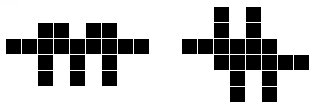Theorem: The set of positive integers $n$ such that there is a $1$-step vanishing polyplet with $n$ cells is $$ \{1,2,9,10,12,14 \} \cup \mathbb{N}_{\ge 15}$$ It can be represented by $1$-step vanishing polyominoes without hole and a non-trivial symmetry group.
Proof: The finite part is given by:

For the infinite part, we will do three steps.
Firstly, the family beginning as follows:
provides the integers $6a+b$ with $b \in \{ 3 , \dots , a+2 \}$. Now, $$6a + (a+2) +1 \le 6(a+1)+3$$ if and only if $a \ge 6$. But $6 \times 6+3 = 39$, so it is ok for $\mathbb{N}_{\ge 39}$.
Next, the gaps of the previous family for $14<n<39$ are given by the set $$\{17,18,19,20,24,25,26,31,32,38\}$$ and can be filled ($n=19,20$ excepted) by the family beginning as follows:
providing the integers $7a+b$ with $b \in \{ 3 , \dots , a+2 \}$.
Finally, $n=19,20$ are given by:
The result follows. $\square$
Bonus question: Can we classify (in some sense) the $1$-step vanishing polyominoes without hole?
There are $21$ such polyominoes with $n$ cells and $n \le 18$.





